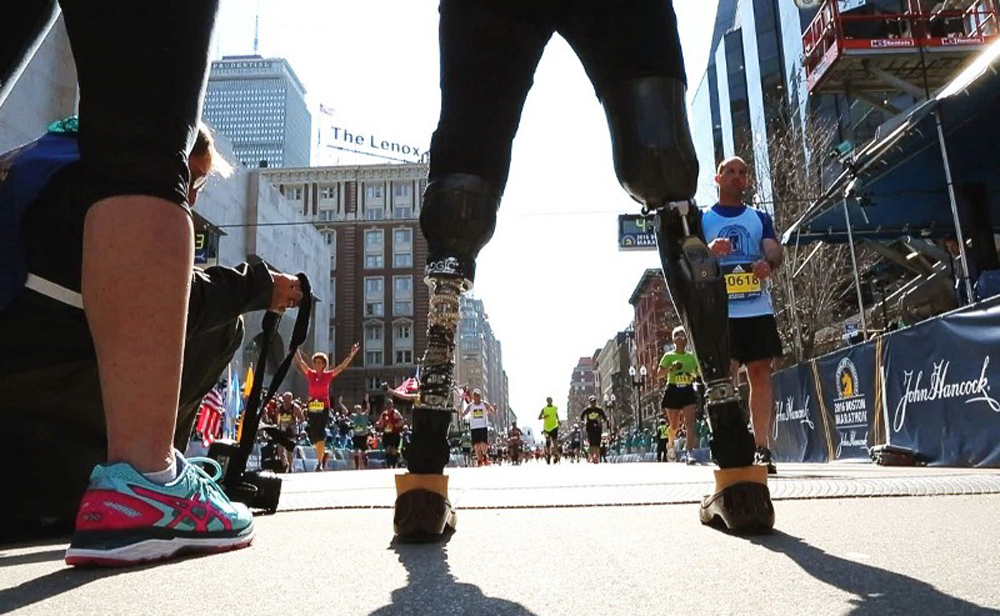When considering making a film about the aftermath of the Boston Marathon bombing in 2013, Annie Sundberg and Ricki Stern realized fairly quickly that they might want to enlist the help of The Boston Globe, which had so thoroughly chronicled the attack. It was a pragmatic decision, but still unique in how it gave access to the filmmakers, renowned for the depth of their own reporting in such films as “Joan Rivers: A Piece of Work,” “In My Father’s House,” the profile of the rapper Che “Rhymefest” Smith, and the Darfur-set “The Devil Rode on Horseback,” to a wealth of information that not only could be drawn on for factual detail, but emotional accuracy as well.
“Since [the photographer] John Tlumacki sent us thousands and thousands of his pictures, you were able to use them in a way that you could string them along so there’d be motion to them and you’d land on a picture or two to get into a moment,” Stern said recently, sans Sundberg, who was attending to a personal matter.
That practical consideration led to one of the most insightful touches in “Marathon: The Patriots Day Bombing,” which may surprise viewers who might expect a straightforward account of the terrorist attack that concentrates on the crime and find instead a warm, empathetic portrait of those who carry on in its wake. In putting a series of stills of the bombing and its immediate effects into motion, Sundberg and Stern replicate the reverberations of how that tragic occasion must replay through the minds of their subjects – three families all with members who suffered grave injuries and claw their way back to some sense of a normal life, albeit with the constant threat of being stopped by their vivid memory of the day it all changed. Tracking the Corcorans, whose matriarch Celeste lost her legs while daughter Sydney was struck with shrapnel, brothers J.P. and Paul Norden, who each lost a leg, and newlyweds Jessica Kensky and Patrick Downes, who each grapple with worse damage to their legs than they originally imagined, “Marathon” shows the long road to recovery in unsentimental yet still moving terms.
By creating such an intimate look at one of the most devastating events in recent U.S. history, Sundberg and Stern give new dimension to the way one looks at these tragedies that have become so commonplace that the world is often eager to move on by the time that survivors need its attention the most. During a recent visit to Los Angeles in advance of a New York premiere at DOC NYC this week and the film’s television premiere on HBO on November 21st, Stern spoke about the experience of joining the survivors of the Boston Marathon bombing in the second year of their rehabilitation, partnering with a newspaper and what it was like to show the film to its subjects.
Annie and I were at HBO, meeting with Sheila Nevins and Nancy Abraham and we had been looking for a year at the subject of terrorism in general and circling it in different ways. The Boston Marathon bombing trial was going on at the time and Sheila actually noted it wasn’t getting front page news – it was somewhere in the middle of The New York Times, [and we wondered] what’s happened to all those survivors? Over 260 people who were injured, some very severely – [there were] 17 amputees – and many more lived in that case than some of the other tragic terrorist attacks, so we started to research what was the aftermath of a terrorist attack and what happens after the media goes away?
As we started to do the research, we realized there was a lot of early coverage of the survivors, but nothing that had over time really shown the impact and over the process of making this film in the past year, there have been the two other domestic attacks as well [as others] abroad, it became important and relevant to look at what happens not only to individuals, but to community, to neighborhoods in the United States. As we were making this film, as the survivors learned about the other attacks, not just in Orlando or San Bernadino, but in Paris or Turkey, they felt very much a kinship with those victims’ families and the survivors.
How did this coalesce around the families you decided to follow?
We were really somewhat overwhelmed in the beginning because it’s such a big story, not only for the people that were impacted directly, but its national and even international implication, so we decided to go very big in telling [the story] over the five days of the capture and then we get to the trial, but then going very finite and intimate into these profound stories of these three survivor families. We partnered with the Globe because they were really the news organization that stayed with these survivors and through one of their photographers [John Tlumacki] who had done early documentation of the Corcorans, it became clear to us that the three families that we chose, in many ways, reflected some aspect of many of the survivors – amputation, but also bearing witness. The father in the Corcorans’ family, saved his wife, but suffers from PTSD, and the daughter almost died by bleeding out. In the other cases, [like with the Nordens, there was Liz] the mother who wasn’t there, and trying to understand what happened to her sons while her sons [who were injured] just moved on with their lives. So a lot of it was trial and error and research, but when we found these three families and we got to know them over a long period of time and in following them, their stories just came out.

When I started to get to know the Corcorans, I was on a long phone call with her and she said, “I think I’m going to get these swim legs in Florida next week, do you want to come?” And I was like, “Yes, we need to start this process, so it was definitely a mixture of filming that whole year [and archival footage]. Jessica Kensky thought was going to be a great year for filming – we actually filmed her at a race and getting a driver’s license and it all went down for her. It was very difficult and she ended up back in the hospital almost continuously all year, so we didn’t really know what we would get.
We started filming around April/May of 2015, so we filmed for about a year-and-a-half, but we were able to gather early footage and photographs, which is why you see that mixed imagery of photographs and snippets of video taken by local news, local press and family members – that footage of the Norden brothers coming out of the hospital and their early rehab at Spaulding [Rehabilitation Hospital in Boston] was [taken by] a family member. But it became a blend of what we could find that led up to it [with what we shot]. We also gave both Sydney and Jessica iPhone 6s that could shoot 4k because some of what they wanted us to portray in their stories was the quiet pain that comes when the news cameras go away and they’re sitting by themselves alone in their room with everything. That was really important to us.
Is this actually the most you’ve had to rely on archival? And does that change the way you make a film?
I don’t know if it’s the most, but there was a lot of research into archival material and the nice thing now is a lot of it just lives on YouTube. You can put in different words and pull up footage, and even at the very end, after we’d been shooting and editing for almost about six or eight months, I found a piece of footage of Paul Norden where he had clearly lost his leg right after the filming and I had never seen that before, so we basically just continued the research all the way through the process of editing and found things at the end that we had to then weave back in early.

Yeah, we were definitely concerned about how much of the actual bombing should be in the telling of what happened the day of the bombing and in the end, I think everyone felt it was appropriate. Jessica Kensky said, “It’s really tough for me to watch and it will be for others, but it’s really important for people to know what it looks like to be blown up by a bomb.” And it was the same thing with Celeste Corcoran. Some of it was just having John Tlumacki, the photographer, say, “I feel guilty showing you in such a raw state and vulnerable state – I wish I hadn’t taken these pictures and put them on the cover of the New York Times and the Boston Globe,” and it’s the survivor herself says, “No, it’s so important that people need to know this is real. This is what we’ve all lived through.” So we really took a lot of cues from them. We don’t do reenactments. We focused on bearing witness and we didn’t want it to be gratituitous, but it’s fairly graphic. there’s certainly images we didn’t show – we didn’t show the people who were killed – and we tried to temper what was important to understand the full impact of this bomb on people’s lives without sensationalizing it.
Since all these people heal on their own time and at the same time are going through a similar process, does that complicate things for you as a filmmaker in terms of the time you spend following them?
Everyone in the beginning had somewhat of a similar journey because we focused on some amputees – you’ve lost your limb, you’re going to have to get a prostheses, you’re going to have to get into rehab, you’re going to have to figure out how to move on with your life. We wanted their stories to compliment each other, so we really did arc them out early – what happened right after the bombing, what was the aftermath – and initially, we didn’t cut the film chronologically. We jumped to the present where they are now and flashed back but it was really hard emotionally to leave the bombing, which was so tragic and dramatic even in the telling, to be with them three years later with them physically doing better. You just really were really in the emotional state of what happened next. So we actually went back and jumped through time a little bit with each of the [survivors’] stories, but cut the five-day search of the brothers and capture [chronologically], which obviously was over a shorter period of time than the recovery.

Yeah, we took our time showing each of the families the film and I don’t want to [speak for them], but everyone responded a little bit differently. For Jessica and Patrick, it’s hard for them to witness it, but I think over time, what I’ve heard, at least from the Corcorans and Liz Norden, is that there’s something cathartic to have this 90-minutes plus where they can relive it, but it’s somewhat controlled and also, it’s providing them with an opportunity to reflect and to process what the past three years has been like for them. I don’t want to say they like it, but they appreciate what [the film is] going to provide for an audience, an opportunity to talk about terrorism and what we societally need to do in providing support for any victims of terrorism.
As editing progressed and you learned of other attacks, did it influence what you wanted to do with this film?
We thought about including something at the end [about other attacks], but we started to look at numbers and the thing is with terrorism and terrorist acts, people have lived with it [forever], so what was important for us was to let Patrick at the end of the film just to say in his own way, reflecting on what happened to them, that there have been many other terrorist attacks and he hopes there’s something in his recovery that will help someone else who’s recovering from something like this.
“Marathon: The Patriots Day Bombing” will play at DOC NYC at the Cinepolis Chelsea on November 14 at 8 pm and November 17 at 9:55 pm. It will premiere on HBO on November 21 at 5 pm.





